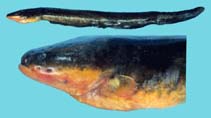| Family: |
Gymnotidae (Naked-back knifefishes), subfamily: Electrophorinae |
| Max. size: |
250 cm SL (male/unsexed); max.weight: 20 kg |
| Environment: |
benthopelagic; freshwater |
| Distribution: |
South America: restricted to the Guiana Shield. |
| Diagnosis: |
Dorsal spines (total): 0-0; Dorsal soft rays (total): 0-0. This species is distinguished by the following characters: ventral outline of head U-shaped, widest at terminus of branchial opening and lateral-line pores 88-101 (vs. ovoid, widest anterior to branchial opening, 112-146 in E. voltai); differs from E. varii with skull depressed, cleithrum lies between vertebrae 5 and 6 (vs. (vs. skull deep with cleithrum lying between vertebrae 1 and 2), pectoral-fin rays 32-38 (vs. 20-28) and lateral-line pores 88-101 (vs. 124-186). Low-voltage (Sachs’ organ) electric organ discharges or EODs and high-voltage (main/Hunter’s organ) with head-positive monophasic waveform. Low voltage EOD 2.03-2.19 ms duration; high-voltage EOD 480 V at 760mm TL (Ref. 120918).
Description: body elongated and sub-cylindrical at pectoral girdle, progressively compressed posteriorly; no scales; superior mouth large with one row of conical teeth on each jaw; anal and caudal fins seamlessly conjoined; anus and urogenital papilla separated and located anterior to ventral margin of branchial opening. Colour of head and body brown to blackish and with a clear band along the body, below lateral line, variably present; three abdominal pairs of electric organs (Ref. 12225, 120918). |
| Biology: |
Prefer muddy bottoms and calm waters; frequently found in coastal plains, swamps and creeks but is also found inland where a favorable biotope exist. Juveniles feed on invertebrates, adults feed on fish and small mammals (Ref. 12225), first-born larvae prey on other eggs and embryos coming from late spawning batches (Ref. 40645). The electric organ of this species consists of flattened electrocytes, numbering to about hundreds of thousands, connected in series (Ref. 10840; 10011). Generates two type of electric organ discharges (EODs) from different electric organs which are of myogenic derivation: 1) low-voltage EODs (about 10 V) emitted by the Sach's organ at rates of up to 25 Hz, and 2) high-voltage EODs (about 50-fold) emitted by the main and Hunter's organs at peak rates of up to several hundred Hz. Low-voltage EOD has been associated with electro location whereas high-voltage EOD has been noted during predatory attacks (Ref. 10011). An EOD of 500 V was recorded from a 1 m specimen (Ref. 10530), making it a potentially dangerous species. Incorporation of this species in fish-based house security systems has been suggested (see Ref. 9506). Also possesses high-frequency sensitive tuberous receptors patchily distributed over the body that seems useful for hunting other gymnotiforms (Ref. 10583). A nocturnal species; captive specimens showed higher low-voltage EOD activity during the night compared to daytime (Ref. 10011). This cycle seems to be free-running (internally controlled) (Ref. 10829). Probably a fractional spawner; fecundity count was17,000 eggs (Ref. 10630). An obligatory air breather (Ref. 10011) and can withstand poorly oxygenated water (Ref. 26457). Used in experimental studies. |
| IUCN Red List Status: |
Least Concern (LC); Date assessed: 12 August 2020 Ref. (130435)
|
| Threat to humans: |
other |
Source and more info: www.fishbase.org. For personal, classroom, and other internal use only. Not for publication.
